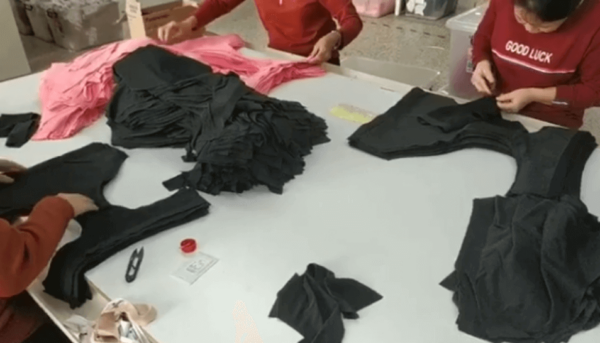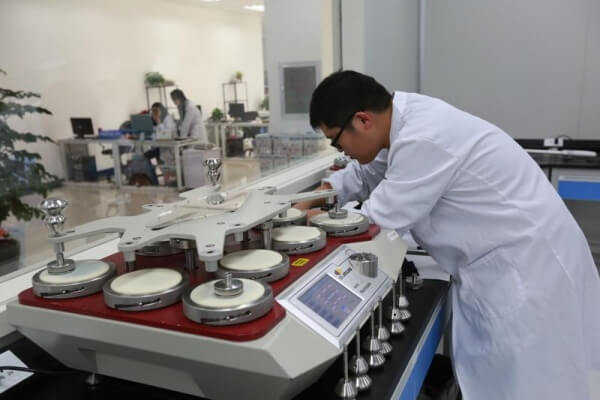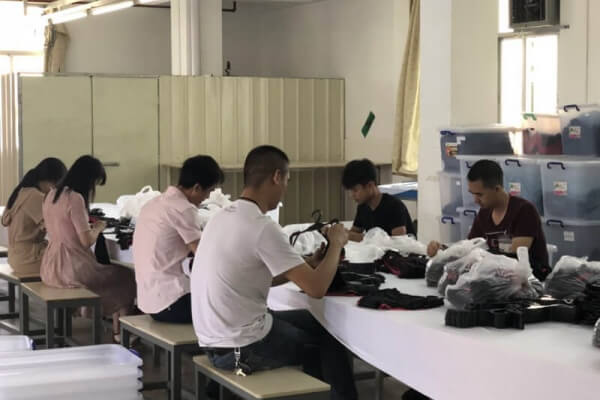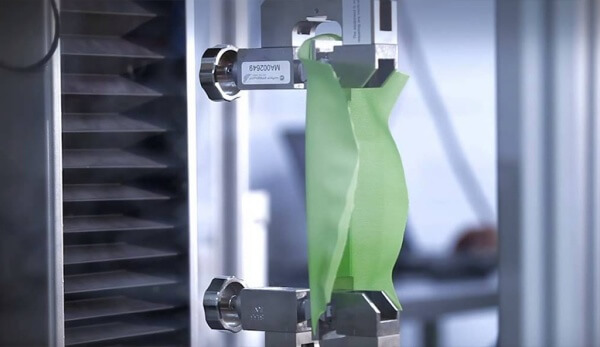Gewährleistung von Produktexzellenz: Qualitätskontrolle & Fertigungsstandards für die Beschaffung von Unterwäsche?
Inkonsistente Qualitätskontrollprozesse führen zu einer unteren Unterwäsche, die nach dem Waschen absaugt oder sich unangenehm anfühlt. Viele Unternehmen entdecken Herstellungsfehler erst, nachdem die Produkte Kunden erreicht, den Ruf der Marke schädigen und die Renditen steigern.
Eine effektive Qualitätskontrolle für Unterwäsche erfordern einen umfassenden Ansatz: Materialinspektion vor der Produktion, Inline-Überwachung während der Baugruppe, standardisierte Absorptionstests, Endproduktinspektion unter Verwendung von AQL-Standards und Waschbehaltungstests, um die Leistung im Laufe der Zeit zu überprüfen.

Wir haben unsere Qualitätskontrollprozesse durch jahrelange Herstellungserfahrung verfeinert und von kleinen Produktionskindungen auf über 2 Millionen Einheiten pro Jahr für große Einzelhändler wie Primark verteilt. Ich habe aus erster Hand gesehen, wie ordnungsgemäß QC -Protokolle den Unterschied zwischen Produkten ausmachen können, die Kunden erfreuen, und denen, die den Ruf der Marke beschädigen.
Was macht die Qualitätskontrolle für zeitgemäße Unterwäsche einzigartig?
Standard -Bekleidungs -QC -Prozesse sind für Unterwäsche nicht ausreichend. Die funktionelle Natur dieser Produkte erfordert spezielle Tests, die viele Hersteller nicht durchführen können.
Periode -Unterwäsche -Qualitätskontrolle muss sowohl die Qualität der Bauwerke als auch die funktionale Leistung überprüfen. Abgesehen von der Standardinspektion des Kleidungsstücks erfordert es spezielle Absorptionstests (Messung der Flüssigkeitskapazität und -aufbewahrung), die Überprüfung des Leckwiderstands und die Waschbehaltbarkeitstests, um sicherzustellen, dass das Produkt die Leistung über mehrere Zyklen beibehält.

Als wir mit der Herstellung von Unterwäsche mit der Herstellung von Unterwäsche begannen, stellten wir schnell fest, dass unsere Standard -QC -Protokolle für Unterwäsche nicht ausreichend waren. Periodenunterwäsche kombiniert Elemente sowohl von Bekleidung als auch von funktionellen Produkten, die einen hybriden Ansatz zur Qualitätssicherung erfordern.
Die doppelte Natur der Periode Unterwäsche QC
Die Qualitätskontrolle der Unterwäsche muss zwei unterschiedliche Aspekte behandeln:
1. Qualität der Kleidungsstunde
Ähnlich wie bei Standard -Unterwäsche umfasst dies:
- Nahtintegrität und Stickqualität
- Identifizierung des Stofffehlers
- Größenspezifikation Einhaltung
- Elastik- und Trimmanwendung
- Gesamtaussehen und Finish
2. Funktionsleistung
Einzigartig für Periodenunterwäsche. Dies beinhaltet:
- Überprüfung der Absorptionskapazität
- Leckwiderstandstests
- Effektivität der Dochtung
- Leistung nach dem Waschen
- Komfort und fit während des Verschleißes
Kritische Fehlerpunkte
Unsere Herstellungserfahrung hat mehrere gemeinsame Ausfallpunkte ermittelt, die besondere Aufmerksamkeit erfordern:
| Fehlerpunkt | Auswirkungen | Erkennungsmethode |
|---|---|---|
| Integrität der durchlaufsicheren Barriere | Leckage während des Gebrauchs | Hydrostatische Druckprüfung |
| Absorptionsschichtverschiebung | Ungleichmäßiges Schutz | Röntgen- oder Hintergrundbeleuchtungsinspektion |
| Zwickelbefestigung | Komponententrennung | Nahfestigkeitstests |
| Abbau von Absorption | Reduzierte Leistung im Laufe der Zeit | Waschzyklus -Test |
Für einen umfassenden Überblick über die technische Unterwäschertechnologie und -materialien finden Sie in unserem detaillierten Leitfaden: Periode Unterwäsche -Technologie & Materialien: Ein Käuferleitfaden zur Absorption, Stoffe & Leckschutz.
Wie sieht ein umfassender QC -Prozess aus?
Viele Unternehmen implementieren unvollständige Qualitätskontrollprozesse, die kritische Probleme verpassen. Ein wirklich effektives QC -System deckt jede Stufe von Rohstoffen bis hin zu fertigem Produkt ab.
Ein umfassender Qualitätskontrollprozess für Unterwäsche in der Periode umfasst fünf wichtige Phasen: Rohstofftests (Überprüfung von Stoffspezifikationen und Sicherheit), Genehmigung der Vorproduktion (Bestätigung von Baumethoden), Inline-Inspektion (Fangprobleme während der Montage), Endprodukttests (Überprüfung der Leistungsmetriken) und Zuverlässigkeitstest (Sicherheitsdauer im Laufe der Zeit).

Wir haben einen mehrstufigen Qualitätskontrollprozess entwickelt, der sich im Maßstab erwiesen hat. Unser Ansatz gewährleistet eine konsistente Qualität, selbst wenn die Produktionsvolumina zunimmt:
Stufe 1: Rohstoffqualitätskontrolle
Bevor die Produktion beginnt, werden alle Materialien strenge Tests unterzogen:
Stofftests
- Physische Eigenschaften: Gewicht, Dicke, Dehnung, Genesung
- Farbeigenschaften: Farbe Fastness zu Waschen, Reiben und Schweiß
- Komforteigenschaften: Feuchtigkeitsdocht, Atmungsaktivität
- Sicherheitstest: Oeko-TEX-Zertifizierung, PFAS-Tests
Absorptionsmaterialüberprüfung
- Absorptionskapazität: Flüssigkeitsretention pro Gramm
- Absorptionsrate: Zeit zum Absorbieren des Standardflüssigkeitsvolumens
- Aufbewahrung unter Druck: Fluidfreisetzung beim Komprimieren
Lecksichtsteuerungstests
- Hydrostatischer Drucktest: Wasserwiderstand unter Druck
- Atmungsaktivitätstests: Luft- und Feuchtigkeitsdampfdurchlässigkeit
- Flexibilitätstest: Drapier- und Bewegungseigenschaften
Stufe 2: Genehmigung vor der Produktion
Vor der Massenproduktion überprüfen wir Konstruktionsmethoden durch Probenbewertung:
- Überprüfung der Konstruktionsmethode: Bestätigung optimale Montechniken
- Nah- und Stichbewertung: Teststärke und Haltbarkeit
- Anpassung der Validierung: Überprüfen Sie die Größe über den Bereich über die Reichweite
- Leistungstests: Überprüfung der Absorption von Vorproduktionsproben
Stufe 3: Inline-Qualitätskontrolle
Während der Produktion führt unser QC -Team regelmäßige Schecks durch:
- Erstes Stück Inspektion: Überprüfen Sie, ob die ersten Stücke alle Spezifikationen erfüllen
- Regelmäßige Intervallprüfungen: Untersuchung von Teilen während des gesamten Produktionslaufs
- Schichtausrichtungsüberprüfung: Gewährleistung der ordnungsgemäßen Positionierung funktionaler Schichten
- Konstruktionskonsistenz: Überprüfung auf gleichmäßige Montagemethoden
Stufe 4: Endproduktinspektion
Fertige Produkte unterziehen sich vor dem Versand gründlich:
AQL-basierte Inspektion
Wir verwenden eine akzeptable Qualitätsniveau (AQL) Standards, um die Inspektionsstichprobengrößen zu bestimmen:
- Kritische Mängel: 0% akzeptabel (Sicherheitsprobleme, wichtige funktionale Ausfälle)
- Hauptfehler: 1,5-2,5% AQL (sichtbare Defekte, geringfügige funktionale Probleme)
- Kleinere Mängel: 4,0% AQL (kosmetische Probleme, die die Funktion nicht beeinflussen)
Leistungstests
Zufällige Proben werden funktionalen Tests unterzogen:
- Absorptionstests: Überprüfung der Flüssigkeitskapazität erfüllt die Spezifikationen
- Lecketests: Bestätigung der Effektivität von Leckschutzbarriere
- Komfortbewertung: Bewertung von Handgefühl und Flexibilität
Stufe 5: Zuverlässigkeitstest
Um langfristige Leistung zu gewährleisten:
- Waschzyklus -Test: Proben zu mehreren Waschzyklen unterziehen (typischerweise 30-50)
- Leistungsaufbewahrung: Messung der Absorption nach dem Waschen
- Strukturelle Integrität: Überprüfung auf Delaminierung oder Komponententrennung
- Elastische Genesung: Überprüfung des Bundes- und Beinöffnungsretention
Informationen zum Aufbau einer vollständigen Unterwäsche -Produktlinie für Unterwäsche finden Sie in unserem Leitfaden auf Kuratieren Sie Ihre Kollektion: Ein B2B -Leitfaden für Zeitunterwäsche -Styles, Absorben & Materialoptionen.
Welche Teststandards sollten auf Periode -Unterwäsche angewendet werden?
Ohne standardisierte Testprotokolle ist es unmöglich, die Produktqualität konsequent zu bewerten. In vielen Unternehmen fehlen klare Testkriterien, was zu subjektiven Qualitätsbewertungen führt.
Periodenunterwäsche sollten nach festgelegten Standards getestet werden: Absorptionskapazität unter Verwendung modifizierter ASTM F1670-Protokolle, Leckwiderstand mit hydrostatischen Drucktests (AATCC 127), Waschbehörde nach AATCC 135 und Materialsicherheit durch Oeko-TEX-Standard 100-Zertifizierung und spezifische PFAs-Tests.

Wir haben Teststandards aus verwandten Branchen angepasst, um umfassende Protokolle für Unterwäsche zu schaffen. Während der Kategorie spezifische branchenweite Standards fehlen, bieten diese angepassten Protokolle objektive Qualitätsmaßnahmen:
Absorptionsteststandards
Kapazitätstest
- Modifiziertes ASTM F1670: Ursprünglich für die Blutdurchdringungsresistenz, angepasst für die Absorption
- Testmethode: Gemessene Flüssigkeitsretention unter Verwendung synthetischer Menstruationsflüssigkeit
- Messung: Ausgedrückt in Millilitern (ML) oder Tamponäquivalenten
- Typische Anforderungen: Leichte (5-10 ml), Medium (10-20 ml), schwer (20-30 ml), Super (30 ml+)
Dochtest- und Verteilungstests
- AATCC 198: Horizontales Docht von Textilien
- Testmethode: Misst, wie schnell und gleichmäßig Flüssigkeit ausbreitet
- Messung: Zeit, um das Standardvolumen- und Verteilungsmuster zu verteilen
- Erfordernis: Schnelle Verteilung von der Oberfläche weg (typischerweise <60 Sekunden)
Leckwiderstandstests
- AATCC 127: Hydrostatischer Drucktest
- Testmethode: Misst die Resistenz gegen Wasserdurchdringung unter Druck
- Messung: Wassersäulenhöhe (cm) vor dem Eindringen
- Typische Anforderung: Mindestens 15 cm Wassersäulenwiderstand
Haltbarkeitsstandards
- AATCC 135: Dimensionale Änderungen im automatischen Waschen
- Testmethode: Misst die Leistung nach mehreren Waschzyklen
- Messung: Prozentsatz der ursprünglichen Absorption erhalten
- Typische Anforderung: >80% Absorptionsretention nach 30 Wäsche
Sicherheitsteststandards
-
Oeko-tex Standard 100: Tests auf schädliche Substanzen
-
Testmethode: Umfassende chemische Analyse
-
Erfordernis: Zertifizierung zu entsprechender Produktklasse
-
PFAS -Tests: Spezifische Tests für Per- und Polyfluoralkylsubstanzen
-
Testmethode: Typischerweise unter Verwendung von LC-MS/MS (Flüssigchromatographie mit Tandem-Massenspektrometrie)
-
Erfordernis: Nicht erfasste Werte oder unter regulatorische Grenzen
Komfort- und Leistungsstandards
- ASTM D4032: Zirkuläres Biegenverfahren zur Steifheit der Stoff
- Testmethode: Maßnahmen, die erforderlich sind, um den Stoff durch eine Öffnung zu schieben
- Messung: Steifheit in Newtons
- Erfordernis: Variiert je nach Stil, sucht aber im Allgemeinen niedrigere Werte für den Komfort
Ausführliche Informationen zu Compliance -Anforderungen und -Zertifizierungsprozessen finden Sie in unserem umfassenden Leitfaden zu Beschaffung mit Vertrauen: Navigieren Sie die Einhaltung, Zertifizierungen & Fabrikstandards.
Wie bewerten Sie die Qualitätskontrollfunktionen eines Herstellers?
Viele Unternehmen wählen Fertigungspartner aus, die hauptsächlich auf dem Preis basieren, nur um Qualitätsprobleme nach der Produktion zu entdecken. Die ordnungsgemäße Bewertung der QC -Funktionen vor der Partnerschaft ist unerlässlich.
Bei der Bewertung der Qualitätskontrollfunktionen eines Herstellers für die Unterwäsche bewerten ihre Testgeräte (Absorptionstestsapparat, Waschbeamten), das QC -Personal (dediziertes QC -Team mit relevantem Fachwissen), dokumentierte Verfahren (standardisierte Testprotokolle) und Verfolgungsbilanz (Erfahrung mit ähnlichen Funktionen und Referenzen von bestehenden Kunden).

Wir ermutigen potenzielle Partner, unsere Qualitätskontrollfunktionen gründlich zu bewerten, bevor wir uns für die Produktion verpflichten. Basierend auf unserer Erfahrung finden Sie hier die Schlüsselfaktoren, um bei der Bewertung eines Herstellers zu bewerten:
Wesentliche Qualitätskontrollinfrastruktur
Testausrüstung
Suchen Sie nach Herstellern mit:
- Absorptionstestvorrichtungen
- Hydrostatische Drucktester
- Testeinrichtungen waschen
- Zugstärke
- Lichtkästen für die Sichtprüfung
Laborfähigkeiten
Im Idealfall sollten Hersteller haben:
- Inhouse Testlabor
- Kalibrierte Messgeräte
- Standard -Testmaterialien
- Dokumentationssysteme
- Oder etablierte Beziehungen zu Testlabors von Drittanbietern
Qualitätskontrollpersonal
Bewerten Sie das QC -Team:
- Personal für die Qualitätskontrolle (nicht nur Produktionsarbeiter)
- QC -Manager mit relevanter Erfahrung
- Personalausbildungsprogramme
- Technisches Wissen über saugfähige Produkte
- Verhältnis von QC -Mitarbeitern zum Produktionsvolumen
Dokumentation und Verfahren
Anfrage und Überprüfung:
- Geschriebene QC -Verfahren
- Testen von Protokollen
- Defekt -Klassifizierungsrichtlinien
- Probenahmepläne
- Aufzeichnungssysteme
- Rückverfolgbarkeitsverfahren
Erfolgsbilanz und Erfahrung
Bewerten Sie die Geschichte des Herstellers:
- Erfahrung mit ähnlichen funktionellen Produkten
- Kundenreferenzen
- Probenqualitätskonsistenz
- Beispiele für Problemlösung
- Initiativen zur kontinuierlichen Verbesserung
Evaluierungs-Checkliste vor Ort
Beobachten Sie beim Besuch potenzieller Hersteller:
| Bereich zu bewerten | Worauf man suchen sollte |
|---|---|
| Materialspeicherung | Saubere, organisierte, klimatisierte, Materialkennzeichnungssystem |
| Produktionsboden | Sauberkeit, Organisation, Beleuchtung, spezielle Geräte für saugfähige Produkte |
| Inspektionspunkte | Sichtbare Qualitätskontrollpunkte während der gesamten Produktion, nicht nur die Endinspektion |
| QC -Bereich | Spezieller Raum, gute Beleuchtung, Testgeräte, Referenzproben |
| Dokumentation | Arbeitsanweisungen an Stationen, Qualitätsaufzeichnungen, Rückverfolgbarkeitssystemen |
Um Anleitungen zur Entwicklung Ihrer eigenen Unterwäsche -Unterwäsche mit zuverlässigen Fertigungspartnern zu entwickeln, finden Sie unsere Ressource auf Ihre Marke, Ihr Produkt: Der komplette Leitfaden für die Fertigung des Händlers für Private Label (OEM/ODM).
Welche Zertifizierungen sind wichtig für die Herstellung von Unterwäsche?
Die Navigation durch die komplexe Landschaft von Textilzertifizierungen kann überwältigend sein. Viele Unternehmen sind sich nicht bewusst, welche Zertifizierungen für Unterwäsche in der Periode wirklich relevant sind.
Zu den wichtigsten Zertifizierungen für Unterwäsche zählen Oeko-Tex-Standard 100 (sicherstellen, dass Textilien frei von schädlichen Substanzen sind), ISO 9001 (Qualitätsmanagementsysteme), Social Compliance-Audits wie BSCI oder Wrap (ethische Fertigung) und optionale Nachhaltigkeitszertifizierungen wie GOTS (für organische Materialien) oder GRS (für Recycled Inhalt).

Wenn wir mehrere Zertifizierungen beibehalten, um sicherzustellen, dass unsere Periodenunterwäsche internationale Standards für Sicherheit, Qualität und ethische Fertigung erfüllt. Folgendes sollten Sie über relevante Zertifizierungen wissen:
Produktsicherheitszertifizierungen
Oeko-tex Standard 100
- Was es zertifiziert: Textilien auf schädliche Substanzen getestet
- Bedeutung: Kritisch für Produkte mit längerem Hautkontakt
- Testen des Geltungsbereichs: Tests auf regulierte und nicht regulierte Substanzen
- Gültigkeit: Erfordert jährliche Erneuerung und regelmäßige Tests
PFAS-freie Überprüfung
- Was es zertifiziert: Produkte frei von Per- und Polyfluoralkylsubstanzen
- Bedeutung: Addressing growing consumer concern about "forever chemicals"
- Testmethode: Spezielle Laboranalyse
- Notiz: Keine formale Zertifizierung, sondern zunehmend wichtige Testdokumentation
Qualitätsmanagementzertifizierungen
ISO 9001
- Was es zertifiziert: Qualitätsmanagementsysteme
- Bedeutung: Demonstriert einen systematischen Ansatz zur Qualitätsqualität
- Anforderungen: Dokumentierte Verfahren, interne Audits, kontinuierliche Verbesserung
- Nutzen: Reduziert das Risiko für Qualitätsinkonsistenzen
Soziale Compliance -Zertifizierungen
Business Social Compliance Initiative (BSCI)
- Was es zertifiziert: Ethische Arbeitspraktiken und Arbeitsbedingungen
- Bedeutung: Überprüft die ethische Fertigung
- Prüfungsbereiche: Faire Löhne, Arbeitszeiten, Gesundheit und Sicherheit, keine Kinderarbeit
- Verfahren: Unabhängige Audits von Drittanbietern
Weltweit verantwortliche akkreditierte Produktion (WRAP)
- Was es zertifiziert: Rechtmäßiger, humaner und ethischer Fertigung
- Bedeutung: International anerkanntes Programm für soziale Compliance
- Fokusbereiche: Arbeitspraktiken, Arbeitsplatzbedingungen, Umweltverantwortung
- Ebenen: Verschiedene Zertifizierungsstufen basierend auf der Einhaltung
Nachhaltigkeitszertifizierungen (optional)
Globaler Bio-Textilstandard (GOTS)
- Was es zertifiziert: Organischer Status von Textilien
- Bedeutung: Relevant für Unterwäsche für Bio -Baumwollperioden
- Anforderungen: Mindestens 70% organische Fasern, eingeschränkte Chemikalien, Umweltmanagement
- Nutzen: Appelle an umweltbewusste Verbraucher
Globaler recycelter Standard (GRS)
- Was es zertifiziert: Recycelte Inhalte in Produkten
- Bedeutung: Relevant für Unterwäsche mit recycelten Materialien für die Unterwäsche relevant
- Anforderungen: Minimaler Recyclinginhalt, Kette der Sorgerechtsprüfung
- Nutzen: Unterstützt Nachhaltigkeitsansprüche
Zertifizierungsüberprüfung
Bei der Bewertung von Herstellerzertifizierungen:
- Aktuelle Zertifikate anfordern (nicht abgelaufen)
- Überprüfen Sie die Zertifizierung über die Website der Ausstellungsgremium
- Überprüfen Sie den Umfang der Zertifizierung (spezifisch für relevante Produkte)
- Fragen Sie nach Verfahren zur Zertifizierungswartung
Besuchen Sie unsere Analyse von marktem Markt und Verbraucherpräferenzen in Bezug auf zertifizierte Produkte Verständnis des Marktes für Unterwäsche: Trends, Demografie & Möglichkeiten für B2B -Käufer.
Abschluss
Die Implementierung einer robusten Qualitätskontrolle und der Einhaltung der Fertigungsstandards ist für eine erfolgreiche Unterwäsche -Beschaffung von wesentlicher Bedeutung. Durch das Verständnis der einzigartigen Testanforderungen, der Einrichtung umfassender QC -Prozesse und der Zusammenarbeit mit ordnungsgemäß zertifizierten Herstellern können Unternehmen sicherstellen, dass ihre Produkte eine konsistente Leistung bieten und das Vertrauen der Verbraucher aufbauen.
Eine umfassende Übersicht über die gesamte Kategorie Unterwäsche, einschließlich Überlegungen zur Herstellung und Partnerschaft, besuchen Sie unsere Ultimativer B2B -Leitfaden zur Beschaffung & Verkaufszeitraum Unterwäsche.
Unser Engagement für die Qualitätskontrolle hat es uns ermöglicht, die Unterwäscheproduktion der Zeit zu skalieren und gleichzeitig herausragende Leistungen zu erhalten und unseren Partnern dabei zu helfen, erfolgreiche Marken in dieser wachsenden Kategorie aufzubauen.
Häufig gestellte Fragen (FAQ)
Was ist das häufigste Qualitätsproblem bei der Herstellung von Unterwäsche?
Die häufigsten Qualitätsprobleme sind inkonsistente Absorption (variierende Kapazität zwischen identischen Produkten) und durchlaufdichtes Barrierefehler (häufig an Nähten oder Kanten). Beide können durch ordnungsgemäße Materialtest- und Konstruktionstechniken verhindert werden.
Wie oft sollte in der Produktion Zeit unter Wäsche getestet werden?
Qualitätsüberprüfungen sollten in mehreren Phasen stattfinden: Genehmigung vor der Produktion, Erstzahlenprüfung, Inline-Kontrollen in regelmäßigen Abständen (normalerweise alle 1-2 Stunden) und endgültige AQL-Inspektion vor dem Versand.
Was ist der Unterschied zwischen Erstanbieter und Drittanbietern?
Erstanbieter-Tests werden vom Hersteller durchgeführt, während Tests von Drittanbietern von unabhängigen Labors durchgeführt werden. Tests von Drittanbietern bieten eine größere Objektivität und sind häufig für die Zertifizierung oder die Konformitätsprüfung erforderlich.
Wie kann ich die Qualitätsansprüche eines Herstellers überprüfen?
Anfragen von Testberichten, besuchen Sie Einrichtungen, um Testverfahren zu beobachten, Kundenreferenzen zu fordern und Stichproben für unabhängige Tests zu bestellen. Beginnen Sie mit einem kleinen Produktionslauf, um die Qualität vor größeren Verpflichtungen zu überprüfen.
Was ist die minimal akzeptable Absorptionsretention nach dem Waschen?
Unterwäsche der Qualitätsdauer sollten nach 30 Waschzyklen mindestens 80% seiner ursprünglichen Absorption beibehalten. Premium -Produkte halten in diesem Zeitraum häufig 90% oder mehr ihrer Absorption.
Wie leite ich Qualitätsstandards für meine Periode -Unterwäsche -Linie fest?
Definieren Sie eindeutige Spezifikationen für Absorptionsniveaus, Leckwiderstand, Waschbehandlung und Komfortfaktoren. Dokumentieren Sie diese in einem umfassenden Tech -Paket und legen Sie Testprotokolle fest, um die Einhaltung der Vorschriften während der Produktion zu überprüfen.
Holen Sie sich ein kostenloses Angebot für Ihre Perioden -Höschenprojekte
